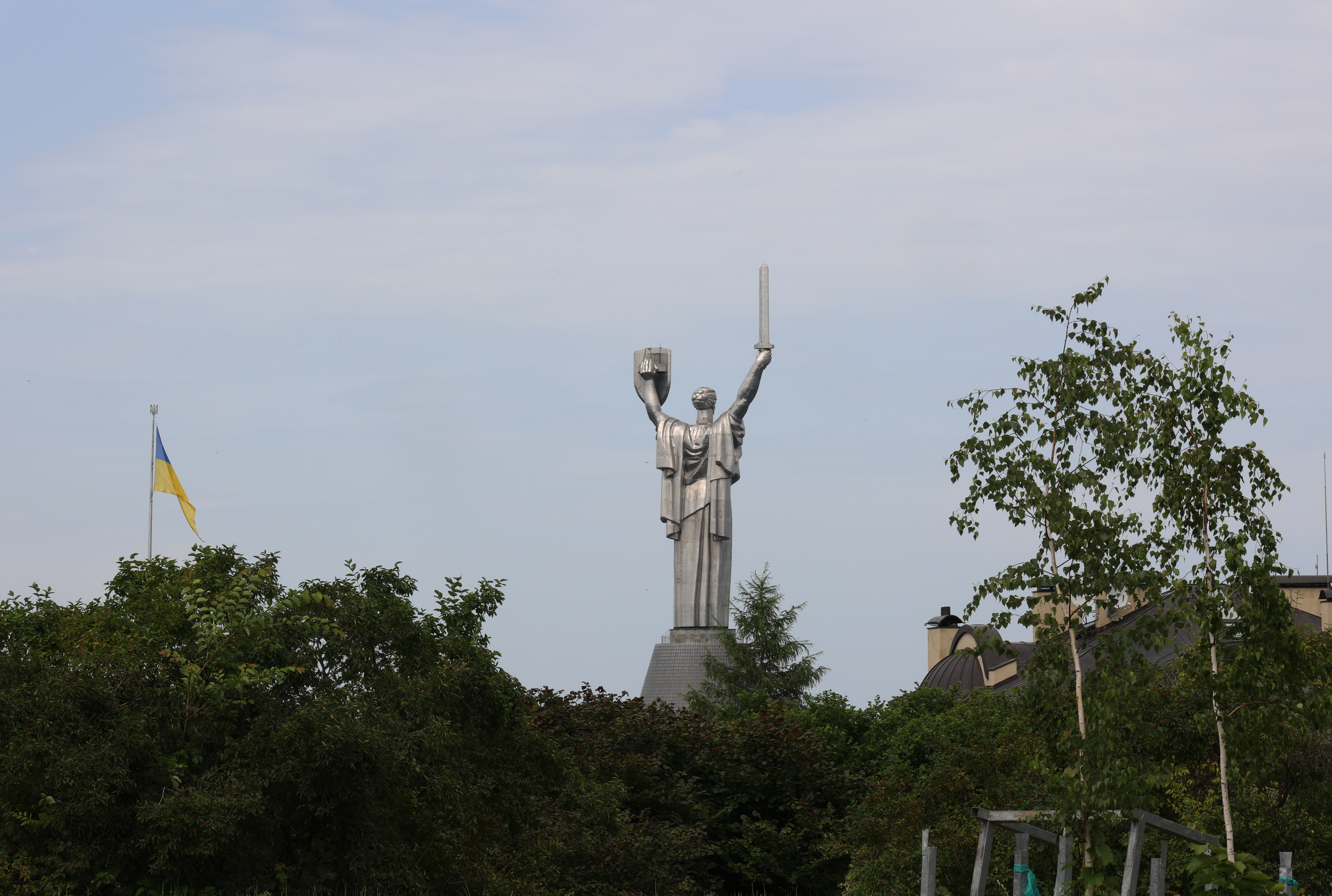Hi!
I am so glad that I have a chance to write to you. This weekly tradition helps me feel more connected with your world. I picture you sitting in your place, perhaps with a cup of something, reading my letter and imagining what life in Ukraine is like.
This life is not good, to tell you the truth. Daily attacks, deaths, damages, and power outages talk with us not only from the newspapers' titles.
But I don't want to sound too gloomy. Let's start our journey into this week, accompanied by photos I took yesterday in the Kyiv National Botanical Garden (except one photo). In the history section, I will share a story highlighting the absurdity of the totalitarian system.
 KEY NEWS
KEY NEWS
FAB-3000
There were many talks about this kind of bomb that russians used for the first time against Ukrainian positions near Kharkiv. Weighing in at three tons, the guided bomb carries a payload of 1.4 tons of Trinitrotoluene (TNT), a robust explosive material. This makes the FAB-3000 particularly devastating upon detonation, capable of causing extensive damage to its target and surrounding areas.
Attacks on energy infrastructure
Ukrenergo reported that on the night of June 19-20, russian attacks damaged civilian energy infrastructure in four Ukrainian oblasts.
The russians carried out a large-scale combined attack on energy infrastructure facilities on the night of June 21-22. Equipment at facilities in Zaporizhzhia and Lviv oblasts belonging to Ukrenergo was damaged.
On the night of June 22-23, russians attacked Kyiv oblast with 3 Kalibr missiles. Ukrainian air defence downed 2 of them. Perhaps there was damage to energy infrastructure, as DTEK (Ukraine’s largest private energy company) announced new power outages.
 Attack on Kharkiv
Attack on Kharkiv
Three people were killed and at least 56 injured, including three children, in a russian airstrike on Kharkiv on June 22. Some photos of the consequences are here.
We are striking back
The drones of the Security Service of Ukraine attacked the Rostov oil depots of Azovprodukt and a branch of Donnefteprodukt in the city of Azov (all russia), which together contain 22 fuel tanks, on the night of June 17-18.
Ukrainian drones attacked four refineries in russia as well as sites where ru drones are stored overnight on June 21. Ukraine's Naval Forces published satellite images which confirm the destruction of storage and preparation sites for Shahed-136/Geranium-2 drones in russia's Krasnodar Krai.
 Oh my, I prepared more news, but let's stop here as I still have that promised story.
Oh my, I prepared more news, but let's stop here as I still have that promised story.
The other day, I came across a book by Ukrainian writer Eduard Adriushchenko called The KGB Archives: Uninvented Stories. The documents of the Soviet state security agencies that have been unsealed in Ukraine have become a real treasure for researchers and journalists. Eduard Andriushchenko turned the stories he found in the archives into articles for Ukrainian and foreign publications, and these materials became a book.
When I saw the photo of putin and Kim Jong Un this week, I recalled a story from the book. I will tell it briefly and add some historical context to understand that era better.
In the Soviet Union, destroying or damaging the portraits of leaders was considered a severe crime. Such episodes happened quite often and were investigated by special state security agencies.
 According to the secret protocol of the Molotov-Ribbentrop Pact, which was signed in 1939 between the USSR and the Third Reich, the Soviet zone included, among other things, Eastern Romania, which included Bessarabia and Northern Bukovyna.
According to the secret protocol of the Molotov-Ribbentrop Pact, which was signed in 1939 between the USSR and the Third Reich, the Soviet zone included, among other things, Eastern Romania, which included Bessarabia and Northern Bukovyna.
A few words about the Pact before I continue telling the story. The Molotov-Ribbentrop Pact (named after the foreign ministers who signed it) was a non-aggression agreement. In addition to the agreement, a secret protocol was signed, which defined the division of Eastern European countries into spheres of German and Soviet interests in case of a territorial and political reorganization of these countries. By the way, the Soviet government long denied the existence of this secret protocol. It was only published in December 1989 from German microfilms. You can read more about the Pact here.
So, the Soviets were planning a full-scale military invasion of Romania. Still, a few hours before the operation, King Carol II of Romania accepted the Soviet ultimatum and agreed to transfer Bessarabia and Northern Bukovyna to the USSR. On August 2, 1940, the Moldavian Soviet Socialist Republic, the predecessor of the modern Republic of Moldova, was established on most of the seized lands.
The Chekists of neighbouring Ukraine initially supervised the work of the Moldovan NKVD.
A photo break
 In early October 1940, a report was sent from Chisinau to Kyiv about an emergency in the Moldovan village of Chabanivka. The report claimed that a local guard, Ivan Nagornyak, took the German flag at the registration office, burned it, took the Führer's portrait off the wall, and tore it up.
In early October 1940, a report was sent from Chisinau to Kyiv about an emergency in the Moldovan village of Chabanivka. The report claimed that a local guard, Ivan Nagornyak, took the German flag at the registration office, burned it, took the Führer's portrait off the wall, and tore it up.
Why were there a Nazi flag and a portrait of Hitler in the village of Moldova? The village of Chabanivka was founded in 1867 by German colonists and was formerly known as Hirtenheim. Germans have lived in Bessarabia since the early 19th century, and by 1940, there were about 100,000 Germans in the region. After the annexation, the Soviet authorities offered Germans a choice: to become citizens of the USSR and continue to live here or to leave for their historical homeland. Almost all Germans chose the second option.
Individuals who wanted to leave were registered at registration points operated by representatives of the Third Reich. In Chabanivka, everyone had been registered by the end of September, so the centre stopped working, and its German employees were preparing to leave. That's when the flag and portrait were vandalized.
A photo break again
 A group of operatives was sent to the place. The story reached the Moscow KGB, and the Germans also learned about it. Against the backdrop of fierce propaganda and the cult of Hitler's personality in Germany, the guard's act seemed like a painful slap in the face. The USSR feared that this situation could lead to complications with the Germans.
A group of operatives was sent to the place. The story reached the Moscow KGB, and the Germans also learned about it. Against the backdrop of fierce propaganda and the cult of Hitler's personality in Germany, the guard's act seemed like a painful slap in the face. The USSR feared that this situation could lead to complications with the Germans.
What really happened?
When the registration office closed, the Soviet representative of the commission offered the Germans to take their property from the building and instructed the guard to remove the German flag and Hitler's portrait. He did it, but he saw strangers outside. He went to find out what was going on. When he returned, the flag and portrait had disappeared.
When the Germans heard about it, they threatened the guard with execution. The guard was frightened and said that he had destroyed, not lost, the symbols (I don't understand why it was better to say that).
'Having conducted an investigation, the operative group found no signs of destruction of the flag and portrait,' the Chekists concluded.
That was the end of the strange and even ridiculous story. I shared it with you to illustrate the terrifying absurdity of the totalitarian regime. I apologize for the lengthy reading; perhaps you even needed the second cup of something.
Okay, let's end the letter. If you think it's worth a cup of warcoffee, you can buy one here. Please don't feel obliged. I appreciate a like and comment as well 😘.
Sincerely,
Yaroslava
